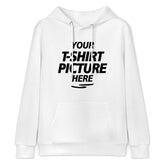Why We Stand by Honest Labeling and FTC-Compliant Tags
In the apparel industry, some unscrupulous merchants create false care labels or import counterfeit clothing from countries like Vietnam and the Philippines. The U.S. is intensifying inspections of these imported counterfeit products, with Vietnam and other countries identified as significant sources of fake clothing (Reference: reuters.com). In contrast, all our products are labeled with accurate fiber content information in full compliance with U.S. Federal Trade Commission (FTC) regulations, using no misleading or fraudulent labels. Our products are 100% manufactured in U.S. factories, with labels printed and sewn in-house to ensure consumers receive reliable information.
Figure 1: Example of a Clothing Label (65% Polyester, 31% Cotton, 4% Elastane) This label clearly lists the fiber components and their weight percentages. U.S. regulations require labels to list the primary fiber components by weight percentage.
Fiber Content Labeling Requirements
- Mandatory Information: Under the U.S. Textile Fiber Products Identification Act and FTC regulations, clothing labels must clearly indicate the primary fiber components and their percentage content. For example, labels should state “100% Cotton” or “60% Cotton, 40% Polyester” (listed in descending order of content).
- Single Fiber: If the garment contains only one type of fiber (e.g., all cotton), it can be labeled as “100% Cotton” or “All Cotton.”
- Blended Fibers: For blended fabrics, fibers must be listed in descending order by content, e.g., “80% Cotton, 20% Polyester.” Fibers constituting less than 5% of the total content typically do not need to be listed individually and can be grouped as “Other Fiber(s),” unless they have a significant functional impact (e.g., elastane for stretch).
- Generic Fiber Names: Labels must use FTC-approved generic fiber names, such as “Cotton,” “Polyester,” or “Wool,” and not brand names or trademarks. FTC regulations explicitly require the use of generic names, as shown in the example with “Cotton” or “Rayon.”
- English Language Requirement: All mandatory labeling information must be in English. Even if the product is exported or sold in non-English markets, English labels are typically required.
Content Tolerance and Compliance Details
Content Tolerance: The FTC allows a small margin of error for fiber content labels. The percentage of each fiber listed on the label may deviate by up to ±3% from the actual content. Exceeding this 3% threshold is considered mislabeling. For example, if a label states 40% cotton, the actual content may range between 37% and 43%.
“100%” Claims: Despite the 3% tolerance, if a label claims “100% Cotton,” the product must essentially contain only that fiber, with no intentional inclusion of other fibers. For instance, a fabric with 97% cotton and 3% polyester cannot be labeled as “100% Cotton,” as this would constitute intentional mislabeling.
Label Permanence: Per FTC regulations, all mandatory information (including fiber content, country of origin, manufacturer information, and care instructions) must appear on a permanently attached label that cannot be removed or obscured before purchase. Typically, this information is included on a sewn-in label, though supplemental hangtags may be used, provided they do not replace the sewn-in label.
Additional Labeling Requirements: Products containing special fillings or components (e.g., decorative pillows, home furnishings, etc.) often require a “law label” specifying the type and proportion of filling materials, such as polyester, foam, or down, using generic names (Reference: bhgs.dca.ca.gov). For example, mattress and pillow labels must detail the filling materials and their percentages. Certain disposable or industrial textiles may be exempt from labeling requirements, but fiber content must still be disclosed on sales pages or invoices.
Legal and Illegal Label Examples
Legal Examples:
- “100% Cotton” (all cotton fiber)
- “80% Cotton, 20% Polyester” (cotton/polyester blend)
- “95% Cotton, 5% Other Fibers” (95% cotton with 5% miscellaneous fibers) These examples correctly use generic fiber names and list content by proportion.
Illegal Examples: Using non-generic or vague terms violates regulations, such as “Pure Cotton” (using a misleading modifier) or labeling as “Cotton Blend” without specifying fiber proportions. Such descriptions are considered incomplete or misleading.
Enforcement and Compliance Tips
The FTC regularly monitors clothing labels in the market, and non-compliance can result in enforcement actions, including fines or product recalls. Imported clothing must also meet these standards, and importers are responsible for ensuring label accuracy (Reference: ftc.gov). Strict adherence to these regulations helps brands avoid legal risks and build consumer trust.
References: The above information is compiled from official FTC regulations and guidance documents, which provide detailed legal requirements for textile labeling, offering brands a reliable basis for compliance.





